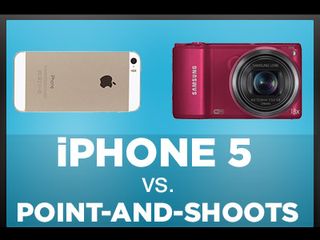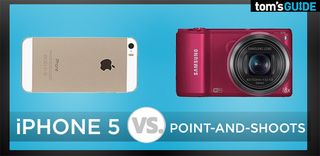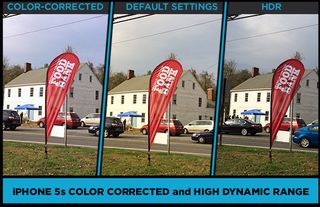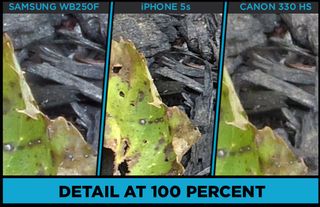In Daylight, iPhone 5s Camera Rivals a Point-and-Shoot
Dark conditions are still a challenge, but by day, the iPhone 5s is as good as — and sometimes better than — even high-end point-and-shoots.


Point-and-shoot cameras are dying, or already dead, thanks to ever-better camera phones — so goes the popular wisdom, anyway. Many photo aficionados are reluctant to agree, though, pointing out that smartphone cameras still have relatively tiny image sensors and lenses that can't match the quality of a "real" camera's gear.
For a long time, that was true. But no more — at least by daylight. We learned that by putting one of the premier phone cameras, the one in the new iPhone 5s (starting at $649, or $199 on contract), against both a midlevel point-and-shoot, the Canon PowerShot Elph 330 HS and a high-end model, the Samsung WB250F.
MORE: Best Free Photo Management Tools
A fitting matchup
These weren't random choices. Apple asserted the high quality of the iPhone 5s camera, and it ranks as our best smartphone camera overall. The feature Apple touts most is the new camera's 15 percent larger sensor, which retains the 8-megapixel resolution of early models, but ups the pixel size to 1.5 microns (about 0.000039 inches) across to absorb more light.
The 1.54-micron pixels of the 12.1-megapixel Canon 330 HS ($180) come very close, which is why we pitted it against the iPhone 5s for our low-light tests in an earlier article (in which the Canon edged out the iPhone). Since it's easier to take photos in bright light, we upped the ante for these tests by also including the Samsung WB250F ($250). To squeeze 14.2 megapixels into its sensor, it has the smallest pixels, at 1.26 micron. Samsung recommended this model to Tom's Guide to test against the iPhone 5s.
The Samsung did not beat the iPhone: The two cameras tied in our test, providing roughly equal quality in all photos, differing mostly in how the camera processed them — using more or less sharpening (processing an image to enhance any edges), for example. Both Samsung WB250F and the iPhone 5s beat the Canon 330 HS in nearly all tests, such as sharpness and color fidelity.
How we tested
We took the three cameras to an autumn festival in a historic town in rural New Jersey. The festival offered a rich palette of colors in handcrafted items, fruits and vegetables, turning leaves and vistas across green fields to historic farmhouses. The day was slightly overcast, but fairly bright. We tested both photo and video quality at default settings and viewed the results on a 13-inch MacBook Pro with Retina Display. We judged photo quality at the sizes you would see on a smartphone screen or posted online; we also zoomed in to full resolution. We played back videos in 1080p HD.
MORE: Best Smartphone Cameras 2013
Overall, the iPhone 5s tends to process photos with higher contrast and deeper blacks; it also sharpens the images more. The WB250F leaves images a bit softer looking. These differences aren't related to the quality of the cameras, but to the choices of their designers.
Color quality
All three models captured rich, but not oversaturated, colors. One craftsperson at the festival had the curious idea to turn old bottles into hanging lanterns. The mixture of red, green and clear glass was virtually identical in all photos.

We found difference, however, in white balance — the ability of a camera to get the right overall hue of light in a scene. Here, the Samsung had the edge: It was dead-on in preserving the white siding of a farmhouse and keeping a red sign from drifting toward orange. The iPhone 5s photos sometimes had a slight "warm" (orange/yellow) cast, but it was generally apparent only when placed side by side with the Samsung photos. The Canon photos, however, often had a pronounced yellowish cast, even making green leaves and grass a bit sallow.

The white balance differences were subtler with Sophie — a fluffy Maltese. The Samsung images were truest to the dog's nearly perfect white fur. The iPhone and Canon photos put a drop of caramel color in the fur.
Dynamic range
The farmhouse photos were also a test of dynamic range — the range of brightness a camera can capture, from the details in shadows to the texture of white objects in bright sunlight. Here, the Canon performed best, showing the branches of trees that were deep in shadow without blowing out the highlights in the house's white clapboards or the slight texture of the light gray skies.
MORE: DSLR vs. Mirrorless Cameras: Which Is Better for You?
The iPhone and Samsung cameras, however, also have a high-dynamic-range (HDR) mode, which combines photos taken at different exposure settings (one for the shadows and one for the highlights) to stretch out the dynamic range. The one-touch HDR feature on the iPhone 5s yielded slightly better dynamic range, but was still no better than the Canon's.

Detail, contrast and sharpness
The three cameras differ quite a bit in displaying detail, which was easy to see in a close-up of leaves fallen onto dark mulch at the base of a tree. The iPhone 5s photo shows every crackle, fold and vein in the autumnal leaves, as well as the finest texture of the woodchips. This is partly a product of sharpening, especially in the leaves. It's also from strong contrast — enhancing the difference between dark and light — which brought out detail in the near uniformly colored mulch.

The Samsung WB250F applied less of both effects, but the images were still relatively distinct, and a bit closer to real life. Picking a "better" picture is subjective. The Canon HS 330, however, captured an overall soft and slightly washed-out image, showing the least detail.
Especially interesting: Displayed at 100 percent size, the iPhone 5s photos looked as crisp as any others, without any more noise (graininess) than there was in the point-and-shoot photos.

Flash photography
The iPhone 5s camera has a unique feature Apple calls True Tone flash with two LEDs — one with an orangey, or "warm," tone, and one with a bluish, or "cool," tone (known as color temperatures). By varying the intensity of the two, the flash system is meant designed to better match the color temperature of the surroundings.
This feature allowed the iPhone 5s to trounce the other cameras when photographing a scene featuring pumpkins, bales of hay and a sign for the festival. The iPhone 5s flash brightened up the sign, and added a slightly warmer tone to the scene. The two conventional cameras each overpowered the photo with the bluish cast of a traditional flash and left a pronounced glare on the sign. (The flash also held up well to traditional flash in our previous low-light tests.)

Video quality
Differences in video quality were pronounced. Similar to many of its photos, the Canon 330 HS video of a rockabilly band appeared soft, with a slight yellowish tint visible on the grass, and generally faded colors. The Samsung's video was better all- around, especially in color and contrast, but the focus was still a bit soft.
MORE: 12 Mobile Video Editors for Your Smartphone or Tablet
The iPhone 5s video was very sharp, from the band in the foreground to the farmhouse across the street. Colors looked right, and plenty of contrast brought out detail and depth. All three cameras captured fairly full sound from their built-in stereo microphones.
Effects and sharing: no contest
To polish up photos it's taken, the Samsung WB250F has detailed editing tools that you control using its smartphonelike capacitive touch screen. Adjustments include Instagram-style filters, and manual control of attributes such as brightness, contrast and color saturation.
But the plethora of apps for the iPhone (or other smartphones) does far more. Sophisticated apps such as Aviary (available for iPhone and Android phones) and PhotoShop Express (for iPhone and Android) have more-powerful editing capabilities, such as removing blemishes and softening the noise (graininess) in photos. These apps allow one-touch sharing to social networks or via email. Of course, dedicated sharing apps such as Instagram and Vine are also available.
Both the Canon 330 HS and the Samsung WB250F are able to send photos over Wi-Fi to a smartphone for editing and sharing. But that's just an extra step.
Zoom: no contest
There is one aspect in which a phone camera can probably never compete: zoom. Even the midrange Canon 330 HS has a 10X zoom lens. The Samsung WB250F has 18X optical zoom.
The only way for a smartphone to compete is by cropping. If posting on Facebook, for example, you need at most 1 megapixel of resolution. Cropping out all but the 1 megapixel in the photo's center provides a kind of zoom effect. But that trick also works with point-and-shoot cameras.
Zoom is possibly the one aspect that will always distinguish point-and-shoot cameras, which should perhaps be called "point-and-zoom."
However, there is one way to zoom in with any camera — walk closer to your subject. So if you are talking photos of anything nearby, or even shooting wide landscapes, and you have a fair amount of light, the iPhone 5s camera is all you need.

Follow Sean Captain @seancaptain and on Google+. Follow us @tomsguide, on Facebook and on Google+.
Sign up to get the BEST of Tom’s Guide direct to your inbox.
Upgrade your life with a daily dose of the biggest tech news, lifestyle hacks and our curated analysis. Be the first to know about cutting-edge gadgets and the hottest deals.
Sean Captain is a freelance technology and science writer, editor and photographer. At Tom's Guide, he has reviewed cameras, including most of Sony's Alpha A6000-series mirrorless cameras, as well as other photography-related content. He has also written for Fast Company, The New York Times, The Wall Street Journal, and Wired.
